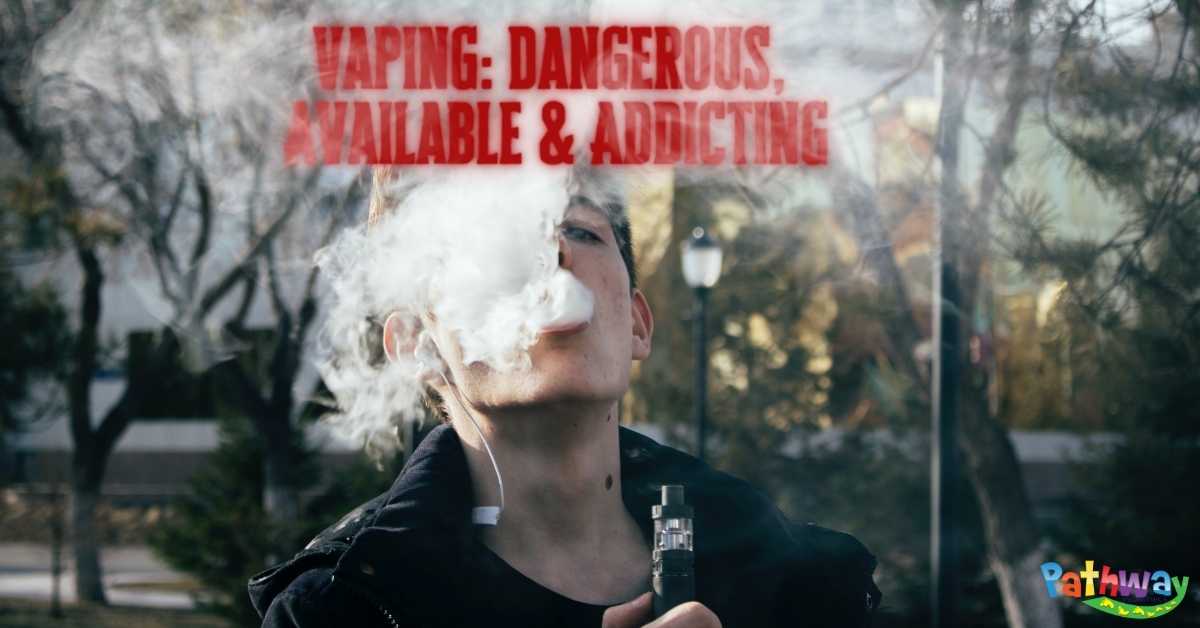Vaping: Dangerous, Available & Addicting
February 22, 2023

What is vaping?
Electronic nicotine devices can look like a pen, a computer memory stick or flash drive, a car key fob, or even an asthma inhaler. Instead of inhaling tobacco smoke from a cigarette, e-cigarette users inhale vapor from liquid “e-juice” that has been heated with a battery-powered coil. This is called vaping. The juice usually contains nicotine and other chemicals.
The liquid solution used in e-cigarettes is usually flavored and appeals to children and adolescents. While flavors were nationally banned in 2019, this ban excludes mint and menthol flavors. Additionally, this ban excludes disposable e-cigarette devices, which are sold in many appealing flavors, are relatively inexpensive, and are increasingly popular with adolescents.
E-cigarettes are the most commonly-used tobacco product among teens. In 2020, e-cigarettes remained the most common tobacco product used by high school (20%) and middle school (5%) students in the last 30 days. Children are exposed to e-cigarette advertising in the media, and in magazines and billboards.
E-cigarettes are unhealthy and addictive.
The Centers for Disease Control and Prevention (CDC) are investigating an outbreak of severe lung disease related to vaping that has caused severe illness and death in many US states. The American Academy of Pediatrics joins the CDC to remind parents that e-cigarette use is never safe for youth, young adults, or pregnant and/or breastfeeding women.
- The solution in e-cigarette devices and vapor contains harmful chemicals like antifreeze (made from one of two chemicals: propylene glycol or ethylene glycol), diethylene glycol, and aldehydes (like formaldehyde) which is ranked as one of the most significant cardiovascular toxins also found in cigarette smoke
- Secondhand smoke/vapor from e-cigarettes is harmful to growing lungs. In fact, studies show long-term, measurable effects on lung health, function, and development.
- The nicotine in e-cigarettes is addictive and can harm brain development.
- Youth who use e-cigarettes are more likely to smoke traditional cigarettes in the future.
- In some cases, e-cigarette devices have exploded, causing burns or fires.
- E-cigarettes can be used to smoke or “vape” marijuana, herbs, waxes, and oils.
- Due to the lack of regulation, the chemical compounds in an e-cigarette device can vary between brands.
Here’s what you should know about teen vaping trends:
- Teens might use different words to talk about e-cigarettes and vaping, including the brand of the e-cigarette device. For example, “JUULing” is a popular word to describe using a brand of e-cigarette.
- Teens can order “e-juice” on the Internet. The legal age to buy e-cigarettes is 21, but online stores don’t always ask for proof of age.
- E-cigarette juices are sold in flavors like mint and menthol. Most have the addictive ingredient nicotine. The more kids vape, the more hooked they become.
- Kids who vape just once are more likely to try other types of tobacco. Their developing brains make it easier for them to get hooked.
- E-cigarettes may not help people quit using tobacco. Some adults use e-cigarettes when they want to stop smoking tobacco cigarettes. While a recent report found e-cigarettes are “less toxic” than cigarettes, most people who use e-cigarettes do not quit using cigarettes. The healthiest option is for parents and their children to quit.
Talk with your child
Make sure that your child is aware of the risk associated with vaping and the use of tobacco and other nicotine containing products.
Talk with your pediatrician
If you have questions about vaping, talk with your pediatrician.
Sources: https://www.healthychildren.org/English/ages-stages/teen/substance-abuse/Pages/E-cigarettes.aspx ; https://www.healthychildren.org/English/health-issues/conditions/tobacco/Pages/Facts-For-Parents-About-E-Cigarettes-Electronic-Nicotine-Delivery-Systems.aspx
Next Post >>